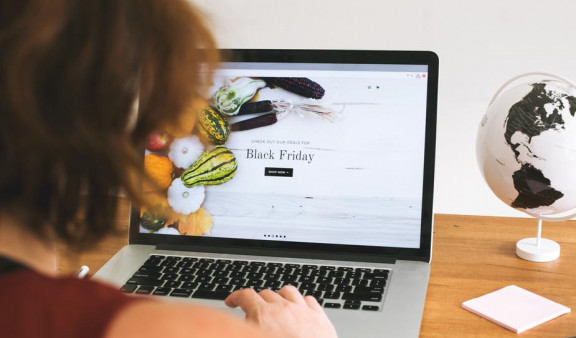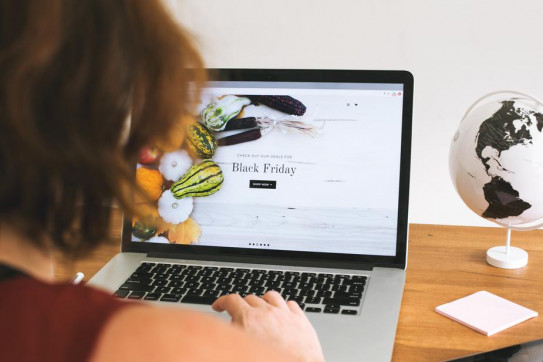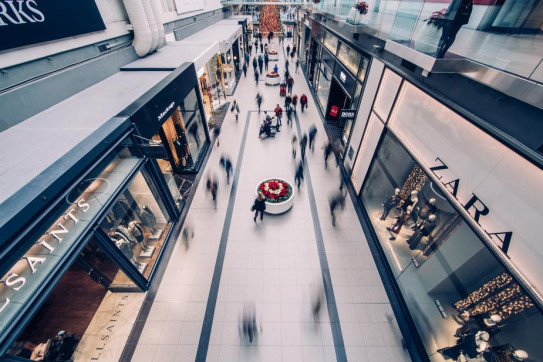
What does Black Friday mean for the ecommerce industry in 2020?
Last year, ecommerce was the big winner after a bumper Black Friday that broke all records.
According to Adobe Analytics, online sales reached $7.4bn in the US, up from $6.2bn the year before. In the UK, Barclaycard said the volume of transactions had risen 7.2 percent year-on-year, with transaction value up 16.5 percent on 2018.
Digital retailers saw this as a positive sign of things to come. Until, that is, COVID-19 came along and turned life and retail in general on its head.
Lockdowns at the beginning of the pandemic caused a huge surge in online traffic across the globe. Enforced shop closures or queues at bricks and mortar stores, combined with mask-wearing and worry of exposure, led to more customers turning to digital means for their essentials first, and then leisure items.
Adobe’s May 2020 Digital Economy Index - that tracks ecommerce trends - found shoppers in the US spent more online during the early COVID-19 months of April and May than in the country’s holiday season of November and December 2019. Consumers spent around $142.5 billion online during these peak shopping months in 2019 – eclipsed by the $153 billion spent this April and May.
What does this all mean for Black Friday this year? Will it be another bumper year for online retail, with confidence in physical stores still in the grip of pandemic lethargy? What trends can we expect to see and why?
Redbox turned to some of its partners to find out their thoughts.
With so much uncertainty in retail in general at present, what do you think Black Friday will look like this year? What are your predictions?
Gavin Laugenie, Head of Strategy and Insight at dotdigital
2020 has proved to be a year of unpredictability. And as a result, it’s been challenging to predict anything accurately. However, many brands have been able to recoup record numbers online during the first lockdown (at the expense of the high street) because it would seem you can always rely on the fact that shoppers love an offer. They can often be swayed to part with their money because of them. Although normally they could get out and hit the high street, shoppers have had no other alternative but to stay home and shop online more than ever before, and in a lot of cases for the first time.
Last year only two days exceeded $2 billion in online sales outside of the holiday season. As of this August, 130 days exceeded $2 billion in online sales! That’s unprecedented. But if brands have planned ahead and thought their strategies through, building up a sense of urgency using; countdown timers; early exclusive access to deals; as well as intriguing subject lines to prompt email opens and dazzling content and creative to drive engagement, I see no reason why this Black Friday can’t be one of the biggest we’ve ever seen on record, especially if the astronomical numbers we’ve seen from Singles Day via Alibaba.com are anything to go by.
Ola Linder, Competence Lead within Content at Star Republic
This is a really tricky question. We were not really sure ourselves, so we posted the question to our staff and our LinkedIn followers. A bit surprisingly, we found that the antipathy towards Black Friday that has been building over the last years is now surprisingly large. Internally, at Star Republic, a whopping 87.5 percent was ‘negative’ or ‘very negative’ towards the Black Friday phenomenon (40 respondents), and the same pattern could be spotted through our LinkedIn followers where the corresponding figure was 76 percent. We can also see, for the first time, a negative trend for the search query "Black Friday" on Google Trends which should imply that the interest for Black Friday is on the decline.
It’s likely that a lot of retailers are sitting on large, unsold stocks of products that have not been of interest to consumers during the pandemic. And these might dump the prices more than usual, creating quite a slump for that market in the upcoming months as consumers stock-up on things that they will need later. We project that industries such as travel, fashion and beauty might be big losers here, for obvious reasons. Consumers have nowhere to go, and no real events to dress up for. The big winners might will be the home improvement (gardening equipment, work-from-home-equipment, furniture, etc) and tech industries. When you can't leave your house, you might as well spend your money on making it as nice as possible. And to kill time and enjoy yourself at home, you can invest heavily in technical gadgets such as gaming, sound systems, home appliances and so on.

Kevin Ward, Director UK Partnerships, Klarna
I think that Black Friday will still be a very significant driver of volumes as it has been in previous years and with the serious growth in social selling, I expect retailers will fully adopt the event to do well. But there will be a hit on margins - competition is tough and the customer holds more power than ever as far as choice and convenience is concerned.
Retailers who fully understand customers’ expectations will be the winners. Those who can remove friction from the journey, provide flexibility in payment methods, delivery costs and drive advocacy will triumph through the process. Industry wise, I think the electronic, fashion and sports brands will do well again. I think experiential gifting may be a surprise front runner as customers are desperate for things to look forward to!
What are your thoughts regarding your area of expertise and how it may be different this year? And have you been working on anything with a client that you are excited to see how it works in practice around Black Friday?
Quentin Montalto, COO ShipperHQ
Gift giving during the holidays will be all about personalisation in 2020. Because gatherings have been limited this year, there's added pressure for the experience to be extra special. Customers will want to put in more time to find that perfect gift instead of purchasing from their go-to online stores. Buying custom made items requiring additional production time, such as an embroidered baby blanket, commissioned art, or a hand-crafted leather bag will be very popular. Of course, that means merchants are on the hook to provide accurate delivery dates for these items at checkout. The absolute last thing a customer wants is for a gift to arrive late. With all the major carriers experiencing shipping capacity issues already, it’s up to the merchant to be 100 percent clear about cut-off times and lead times so customers are encouraged to buy items sooner rather than later.
Daisy Sorrell-Rhodes, Marketing Manager, Akeneo
Making seasonal changes in your product catalogue isn’t as simple as flipping the calendar to the next month. It means onboarding new products from manufacturers and suppliers, adding new photos and other digital assets, and updating hundreds or thousands of SKUs on multiple sales channels in time for the new season - all without succumbing to errors and inaccuracies in your product information. Add it all up, and adapting your product catalogue can be a monumental undertaking.
Many of our retail customers are implementing a PIM in order to categorise their products according to sale or theme, such as Black Friday, Christmas or Valentine’s Day. We can attest to this improving and even replacing that in-store customer experience that the UK is lacking due to lockdown.
Kevin Ward, Director of UK Partnerships, Klarna
From a marketing perspective, we are aligning with many of our key clients to ensure that we drive our ecosystem in line with our merchants. Klarna has 9.5m UK customers who are very loyal to our brand. One of our key drivers is to ensure that our customers know who we partner with in order to drive adoption and repeat purchases within our partner brands. We have a number of promotions taking place with our merchants that ensure that the end customer is fully aware that Klarna is available as their favourite way to pay. Activations like this take away friction from the purchase journey but most importantly, drives awareness between the Klarna and the customer ecosystem. We also see huge numbers of customers navigate from our Shop function on https://www.klarna.com/uk/ and through our 2.1m App users straight to our merchants site's resulting in phenomenal traffic and conversion for all of our partners.
Are digital strategies for Christmas likely to change depending on what happens around Black Friday? With so much shopping now taking place online, how is this likely to impact retailers in the lead up to Christmas?
Daisy Sorrell-Rhodes, Marketing Manager, Akeneo
Although shops in the UK plan to re-open to some extent to socially distanced shoppers, retailers will still need to be ready for the majority of their sales to take place online. City centres, where the typical British Christmas shopping experience is bustling shops with queues for days will be a thing of the past. As shops do start to open, it won’t be easy or quick for customers and the in-store stock cannot be guaranteed. That being said, many shoppers will elect to continue the online shopping preference in the comfort of their own home.

Kevin Ward, Director of UK partnerships, Klarna
This will massively come down to whether or not lockdown is eased. If it is, then I can see some decent brick and mortar adoption as people will be keen to see some 'normality' in the run up to Christmas. Black Friday, although great for consumers hasn't had a significant adverse impact on Christmas trading and I don't expect it to this year either. What I do expect is that those retailers who have been proactive in both lockdowns in nailing their social strategy and enhancing their Tech Stack to do very well in the period. With customers now owning the narrative on where and how they buy, retailers must be able to solve as many customer issues as possible. With mobile adoption now hitting dizzy new heights it is essential that retailers do everything they can to convert, maximise and retain the customer from the very first visit.
Ola Linder Competence Lead within Content at Star Republic
The statistics here in Sweden indicate that while Black Friday is growing, the Christmas shopping period is actually declining. In fact, the average Swedish salary is increasing at about double the rate of the average consumption, which implies that consumption as a whole is actually on the decline. So, it would seem rather obvious that Black Friday is cannibalising the sales you already have, the only difference is that you have a re-distribution throughout the year of when the sales are done. And especially from the Christmas period to the November shopping holidays. While this might sound rather obvious, retailers need to consider what products that they are going to sell before Christmas and instead try to get rid of the things that might not normally be considered "Christmas gift material”. Also, considering the growing scepticism towards what's being perceived as a consumption frenzy out of touch with the times we are living in, you might instead use this opportunity for brand building by considering going your own way and standing up to the hype. That is, if you are in a position where you can afford to be standing on the side lines.
What advice or expertise would you pass on to digital retailers about Black Friday this year and how they should be planning for the year ahead?
Paul Camicas, E-commerce Practice Manager, SQLI
In terms of communication, the large market places currently tend to avoid this term, which has been made unpopular by the grumbling of traders. These last few days, I have noticed that they are offering Black Friday promotions, but are linking them to the more consensual Christmas party.
In the run-up to the event, brands must therefore choose relevant terms for their communication, avoiding the term Black Friday. Of course, they must also do what they already know how to do: organise rarity but avoid out-of-stock situations; apply discounts only on part of the collection; define offers by customer segment; prepare campaigns to relaunch abandoned baskets.
Downstream of the event, CDOs should plan to analyse all the behavioural data collected in the war room, bringing together the company's various departments (marketing, network, IT and management control departments) immediately after the event. Indeed, at a time when dataism is establishing itself as a sustainable way of thinking, we paradoxically suffer from an excess of data collection and a crying lack of analysis of this data. We therefore need a ritual whose function is simple: to understand our clients, to make relevant segmentations and to refine the personalisation of the experience in the broadest sense (personalisation of paths, products and messages).
Kevin Ward, Director UK Partnerships, Klarna
Shout about it! It is still happening and will still drive significant volumes for all merchants. Merchants need to nail their social shopping element and ensure a frictionless end-to-end journey. Free delivery, guest checkout, bold on-site messaging and promotional PDP are an absolute must. For next year, merchants must have all of the taps on with regards to their Tech Stack. They must partner with world class technologies that elevate their brand and allow them to acquire new customers through the partner ecosystem. 2021 will still be driven by online, so merchants must be ready!